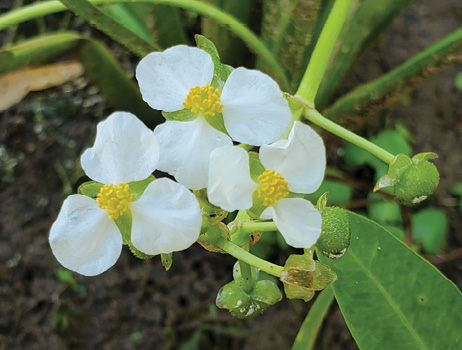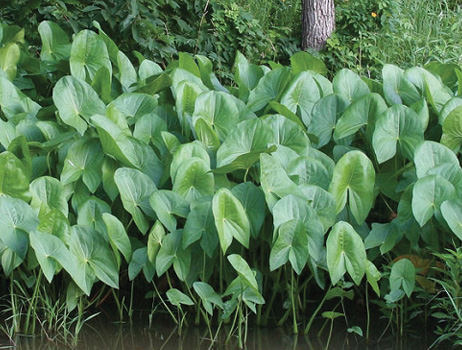Arrowhead | Sagittaria spp.
Emergent | Native and Non-Native

vibrant flowers with three petals.


There are at least seven species of Sagittaria in Mississippi. Most species of this attractive plant resemble the common garden species taro, elephant ears, and caladiums in shape. However, shape is variable among species.
The leaves can be found both above and below the water surface, and they can grow high above the water on long stalks. They are shaped like a spade, deeply notched like an arrowhead, or lance shaped.
Flowers are produced during the summer and are usually white with three petals. Pink flowers can occur but are less common.
Giant arrowhead, Sagittaria montevidensis, is non-native and invasive and can be identified by the brownish-purple spot at the base of each flower petal. Although uncommon in recreational ponds, this species should be eliminated upon first detection. Other Mississippi species are native and rarely become a problem in ponds.
Management Value
Giant arrowhead, Sagittaria montevidensis, is non-native and invasive, and should be eradicated upon first detection.
Other Mississippi species of this plant are native and important for wildlife. The tubers are eaten by people, muskrats, and waterfowl. In fact, one common name for Sagittaria is duck potato. Arrowhead tubers are considered an important part of the Native American diet—the Cree tribe called them wapato. Some raw tubers are edible but become less bitter when cooked. The seeds also provide food for different wildlife species.
It is important to note that another native species, Peltandra virginica, which is very similar in appearance to some species of Sagittaria, can be poisonous if not prepared properly before eating.
Arrowhead are a species that can be introduced around shorelines to improve aesthetics and provide habitats for wildlife and fish. They spread relatively slowly, allowing for both mechanical and herbicidal control when necessary.
Recommended Controls
Option 1: Glyphosate (5.4-pound formulation). For each gallon of water, mix 3.8 ounces glyphosate and 1.3 ounces surfactant. Spray to wet all exposed plants. Do not exceed annual herbicide rate limits as stated on the product label.
Option 2: Imazamox (1.0-pound formulation). For each gallon of water, mix 1.2 ounces imazamox and 1.3 ounces surfactant. Spray to wet all exposed plants. Do not exceed annual herbicide rate limits as stated on the product label.
Option 3: 2,4-D (3.8-pound formulation). For each gallon of water, mix 5.1 ounces 2,4-D and 1.3 ounces surfactant. Spray to wet all exposed plants. Do not exceed annual herbicide rate limits as stated on the product label.
For some arrowhead species, multiple applications may be necessary to achieve eradication.
The best approach to control this species is to treat ponds with herbicides when the water temperature is at least 60˚F and the plants are actively growing. For options 2 and 3, it would be best to treat one-third of the pond at a time, with a week or more separating applications.
After the entire pond has been treated, a repeat application for the entire pond may be necessary to eliminate remaining plants.
Read and follow all chemical label instructions, especially the section on the use of personal protection equipment.

The information given here is for educational purposes only. References to commercial products, trade names, or suppliers are made with the understanding that no endorsement is implied and that no discrimination against other products or suppliers is intended.
Publication 3735-17 (POD-11-23)
By Wes Neal, PhD, Extension/Research Professor, Wildlife, Fisheries, and Aquaculture; Dennis Riecke, Fisheries Coordinator, Mississippi Department of Wildlife, Fisheries, and Parks; and Gray Turnage, PhD, Assistant Research/Extension Professor, GeoSystems Research Institute.
The Mississippi State University Extension Service is working to ensure all web content is accessible to all users. If you need assistance accessing any of our content, please email the webteam or call 662-325-2262.



